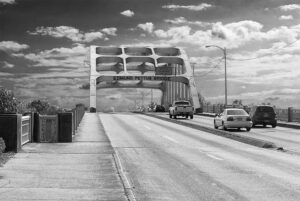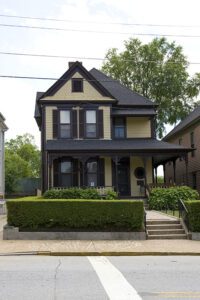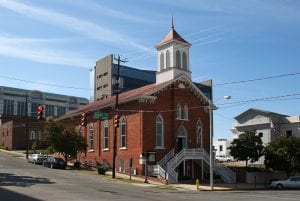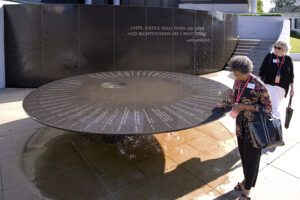After participating in the M.L. King Day of Service, take a tour of civil rights landmarks and learn more about Dr. King and the U.S. Civil Rights Movement.

Edmund Pettus Bridge, US Route 80, Selma, Alabama
In 1957, Martin Luther King delivered a sermon he titled, “Three Dimensions of a Complete Life.” In the sermon, he said in part,
“In a sense every day is judgment day, and we, through our deeds and words, our silence and speech, are constantly writing in the Book of Life.
Light has come into the world, and every man must decide whether he will walk in the light of creative altruism or the darkness of destructive selfishness. This is the judgment. Life’s most persistent and urgent question is, ‘What are you doing for others?’”
The question Dr. King asked, “What are you doing for others,” has become the theme of the national King Day of Service.
To honor Dr. King today, millions of Americans will volunteer to serve in their communities.

Global Citizens, which organizes King Day in Philadelphia, recognizes that across the nation, millions of volunteers are now “turning their community concerns into volunteer service and ongoing citizen action on King Day and beyond.”
This year, we are emerging from the devastating COVID pandemic, which has touched the lives of almost everyone in the US. More than 103 million cases of COVID have resulted in more than 1,125,000 American deaths since the pandemic began. While participating in this day of service, let’s not forget our friends, neighbors and family who have been lost in recent years due to the COVID virus.

Childhood home of Reverend Dr. Martin Luther King Jr. in Atlanta, Georgia.
As we volunteer today to help others, perhaps we can also plan to travel to U.S. historic sites to help us remember and understand our history. Travel to historic sites can bring past events and the lives of those who participated in them into sharp perspective. It can help us learn valuable lessons to use in our future.
Plan a tour of M.L. King’s historic sites in Atlanta, Montgomery, and Selma, Alabama.
Specifically, I’d like to suggest that while we honor Dr. King today by serving the people in our communities, we begin to plan a trip to visit some of the historic locations and civil rights landmarks important in the short life of Dr. King. Through that journey I hope we can, at least in part, be enabled to honor and learn about the man whose courageous actions influenced and helped shape our nation during the twentieth century.
Visit Dr. King’s childhood home, the Ebenezer Baptist Church, and the MLK National Historic Site in Atlanta, Georgia.
We can start in Atlanta, Dr. King’s birthplace and childhood home. He grew up there with his older sister, Willie, and his younger brother, Alfred. The home, a modest middle-class wood frame structure, stands today much as it did when he lived there. In the home, you can begin to get a feel for young Dr. King’s family life.
From there, you can walk a block and a half to the Ebenezer Baptist Church. During the Great Depression, Dr. King’s father, Martin Luther King Sr. became the leader of the church in 1931. Despite the Depression, Rev. King Sr. organized membership and fundraising drives which enabled the struggling church to begin to thrive. He fought for equal justice and civil rights his entire pastoral life. In 1960, Dr. King Jr. joined his father as co-pastor of Ebenezer.
Also near the King family home is the Martin Luther King Jr. National Historic Site. Its Visitor Center, the Dream Gallery, the King Center, the World Peace Rose Garden and Dr. King’s tomb, are all worth taking time to visit.
Don’t miss the Dexter Avenue Church and the Civil Rights Memorial in Montgomery, Alabama.

Dexter Avenue Church, Montgomery, Alabama
From Atlanta, you can journey to Montgomery, Alabama. There you can visit the Dexter Avenue King Memorial Baptist Church, just a few blocks from the Alabama State Capitol building. Dr. King became pastor of the Dexter Avenue Church in 1954, at the age of twenty-five.
Just a year later, after Rosa Parks was arrested for refusing to give up her seat on her bus, the Montgomery Bus Boycott began, led by Dr. King and others. The boycott lasted more than a year, and during it, Dr. King’s home was firebombed. Along with other leaders, Dr. King was arrested during the boycott.
Dr. King continued to preach non-violent action for civil rights and justice from the Dexter Avenue Church pulpit. In 1957, he and others, including Ralph Abernathy, founded the Southern Christian Leadership Conference. He went on to fight for civil rights in Birmingham, Selma, St. Augustine, and across the nation until his murder in 1968. Follow his civil rights landmarks across the South.
Consider going to Sunday church services in the Dexter Avenue Church. Sitting in the pews, before Dr. King’s pulpit, was a very moving experience for me when I was last there.
See the Civil Rights Memorial Center sculpture designed by world-famous sculptor, Maya Lin.
The Southern Poverty Law Center and Civil Rights Memorial Center is located behind the church. The Center has exhibits about the Civil Rights Movement, a small theater and classroom.

Southern Poverty Law Center Civil Rights Memorial, Montgomery, Alabama
In front of the Center is the Civil Rights Memorial, designed by Maya Lin, who designed the Vietnam Veterans Memorial. The Memorial honors the achievements and memory of those who died during the Civil Rights movement from the time of the 1954 Supreme Court decision of Brown vs. Board of Education, to the assassination of Dr. King in 1968.
The black granite table at the center of the Memorial records the names of those who died during the movement, and chronicles its history. Water emerges from its center, flowing across its top, and over its side, reminding all of Dr. King’s paraphrase of Amos 5:24,
“…we will not be satisfied, until justice rolls down like waters and righteousness like a mighty stream.”
Visit the Edmund Pettus Bridge in Selma, Alabama, the site of “Bloody Sunday.”
From Montgomery, I would suggest visiting Selma, Alabama’s Edmund Pettus Bridge, the site of “Bloody Sunday” in 1965, where eventually Dr. King, John Lewis, and other civil rights leaders, clergy, and everyday people were able to march to Montgomery.

(All images are Copyright © 2023, NSL Photography. All Rights Reserved.)
After many years working in corporate America as a chemical engineer, executive and eventually CFO of a multinational manufacturer, Ned founded a tech consulting company and later restarted NSL Photography, his photography business. Before entering the corporate world, Ned worked as a Public Health Engineer for the Philadelphia Department of Public Health. As a well known corporate, travel and wildlife photographer, Ned travels the world writing about travel and photography, as well as running photography workshops, seminars and photowalks. Visit Ned’s Photography Blog and Galleries.



